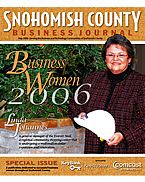 |
|
|
YOUR
COUNTY.
|
YOUR
BUSINESS JOURNAL.
|
Successful
managers empower
their employees
 “One
day, Alice came to a fork in the road and saw a Cheshire cat in a tree.
‘Which road do I take?’ she asked. ‘Where do you want to go?’ was his
response. ‘I don’t know,’ Alice answered. ‘Then,’ said the cat, ‘it doesn’t
matter.’” — Lewis Carroll
“One
day, Alice came to a fork in the road and saw a Cheshire cat in a tree.
‘Which road do I take?’ she asked. ‘Where do you want to go?’ was his
response. ‘I don’t know,’ Alice answered. ‘Then,’ said the cat, ‘it doesn’t
matter.’” — Lewis Carroll
My day started with a glib comment to the manager of my local coffee spot about a recent management change at her corporate headquarters, one in a long string of management changes.
This 25-year-old then spent 30 minutes outlining her vision for the company, along with a long list of strategies to re-energize the demoralized rank and file. Her thinking was impressive.
I’ve known her for five years and, though she isn’t through college yet, she knows more about effective management than the so-called experts. You should hear her talk about brand strategy, employee reward systems, harnessing the energy of front-line employees (who actually talk to customers).
Given the power, I know she would double the output and profitability of her store. But her management doesn’t believe in giving power to young employees. They DO believe in providing a long list of policies and “thou shalt nots.” From an employee perspective, management is out to lunch where it is needed most — providing encouragement.
Question: Is the purpose of management really to manage? Or is it to lead?
Too many bosses have all the answers, and what they expect of their employees is implementation only. This limits creativity, depletes enthusiasm and reduces profitability. It also leads to turnover of the brightest people, and those left are those who are great at taking orders. This is good for the army. I’m not sure it’s a good management policy.
I was very fortunate to work for the Walt Disney organization at a time when Walt’s crew was still in place. The “Disney Values” were alive and well in those days. I also was 25 and full of ideas, just like our young coffeehouse manager.
A young copywriter, Paul Goldman, and I got the bright idea to invite Ward Kimball to dinner one night. This was a bold move, given Ward’s place in Disney history, but he took the time to meet with two wide-eyed admirers.
He was one of Walt’s most important creative contributors in the early days of Disney. Ward was an animator of “Snow White” during the Great Depression, did the pink elephant scene in “Dumbo” and led the move to new forms of animation in the 1950s with “Toot, Whistle, Plunk and Boom.” He also was recruited by Walt to work on the early designs of what Hollywood called “Disney’s Folly,” now better known as Disneyland.
Paul and I grilled Ward about Walt Disney. How did he act? What was he like to work with? How did he accomplish so many things? How did his company maintain creativity as it grew? I’ll never forget two important points that Ward made about Walt:
First, Walt continually challenged his creative people to do things that had never been done before. Walt wanted more and more realism, often way beyond the current state of the animation industry.
“He believed more in my abilities to do impossible things than I did. We were often frustrated by how much he demanded of us. It was not always fun,” Ward recalled. “Disney was insatiable. But he didn’t tell his people how to do their work; he just demanded that they reach very high and then reach even higher. Once we learned that we could do amazing things, it really motivated us to outdo each other.”
This era led to numerous Academy Awards and all sorts of new technological inventions to improve animation. This led to a general feeling at Disney that there was little they couldn’t accomplish.
The second reason for Disney’s early success was attributed to Walt’s clear communication on exactly where he wanted his organization to head. There was no ambiguity. Walt was the boss, and when he said that a goal had to be reached, your job was to figure out how to reach it. And reach it they did every single time for 40 years.
It’s no accident that Disney hired people who were young and had not yet learned just where the barriers were in life. Today, we use personality profiling and other techniques to find just the right people. But I think Walt’s way was best when he advocated finding people “who get up on the sunny side of the bed.” The organization attracted the kind of people who — no matter the challenges — got up each day ready to tackle the next thing.
The greatest gift our management can give us is clear direction about where our organizations are heading. Good employees will do the rest.
Bill Fritsch, a longtime leader in Seattle’s ad industry, is president of Hydrogen. Call him at 206-389-9500, Ext. 224, or send e-mail to bill@hydrogenadvertising.com.













